NORTH WALES COAST RAILWAY:NOTICE BOARD
Rheilffordd arfordir gogledd Cymru: Hysbysfwrdd
04 July 2016
Share on Twitter
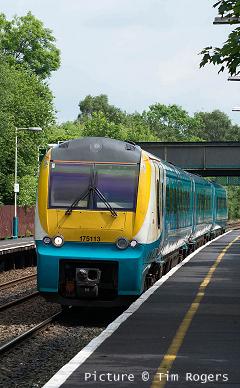
Tweets by @NWrail1
Contributions and comments are encouraged: see the Contributions Page
This list may be out of date if you are reading an archived issue. For full information visit our Calendar page.
July 2016
Sunday 24 July Railway Touring Company THE NORTH WALES COAST EXPRESS Liverpool-Holyhead (WCRC) Steam loco 45690 or 46100: Liverpool - Chester - Holyhead and return
Tuesday 26 July Railway Touring Company THE WELSH MOUNTAINEER Preston - Blaenau Ffestiniog . Steam loco 45305 or 48151: Preston - Chester - Blaenau Ffestiniog and return
August 2016
Sunday 21 August Railway Touring Company THE NORTH WALES COAST EXPRESS Crewe - Manchester - Holyhead (WCRC) Steam loco 45690 or 46115: Manchester - Chester - Holyhead and return
September 2016
Sunday 4 September Railway Touring Company THE NORTH WALES COAST EXPRESS Crewe - Manchester - Holyhead (WCRC) Steam loco 45690 or 46115: Manchester - Chester - Holyhead and return
Friday 30 September Great Western Society North West Branch. Steam in Black and White. Peter Spilsbury.
October 2016
Friday 28 October Great Western Society North West Branch. Railway Personnel. Paul Shackcloth.
November 2016
Friday 25 November Great Western Society North West Branch. GW Steam in S. Wales and S West. Alf Storey
December 2016
January 2017
Friday 27 January Great Western Society North West Branch. North of Preston Barrie Rushton
February 2017
Friday 24 February Great Western Society North West Branch. Group AGM
March 2017
Friday 31 March Great Western Society North West Branch. (To be announced)
April 2017
Friday 28 April Great Western Society North West Branch. (To be announced)
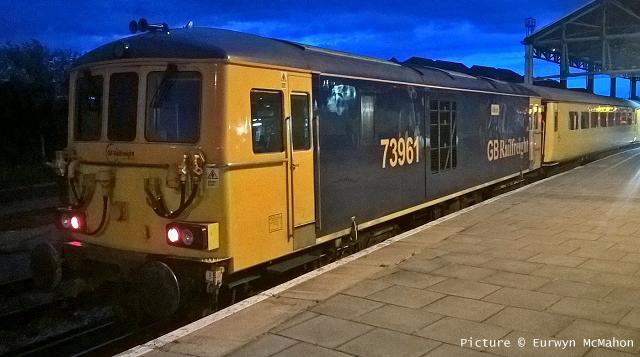
Rebuilt electro-diesel 73 961 Alison at Chester with the 13:13 Network Rail train from Derby to Crewe via Chesterfield, Buxton, Northwich, Wrexham, Bidston, Chester, Ellesmere Port and Ellesmere Port on the evening of 4 July. The train was scheduled to visit the Merseyrail network, for which the electric option of the Class 73s would have been useful, but this did not happen. After its second visit to Chester the train travelled direct to Crewe. Picture by Eurwyn McMahon.
Freight views
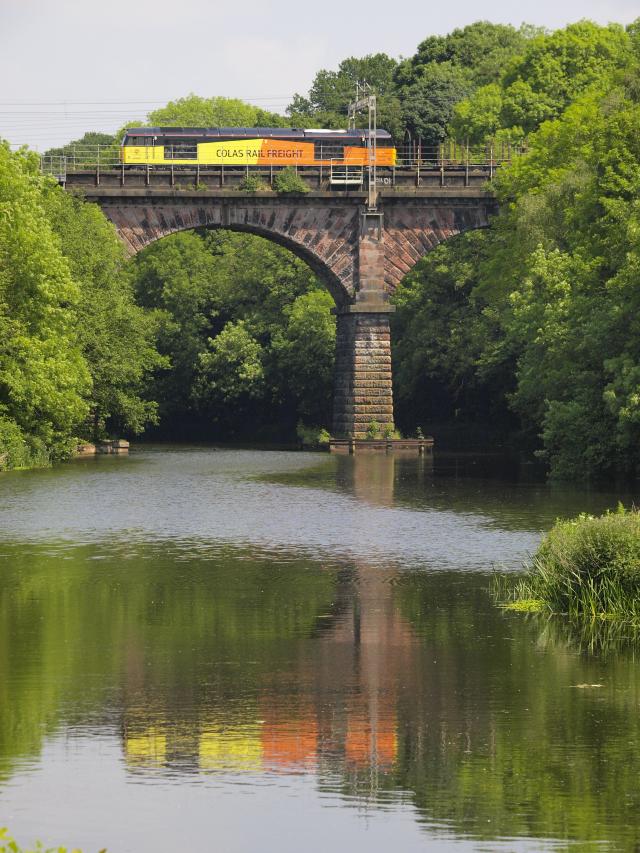
Chris Poole sends this reflective view to show us that his home town of Hartford is 'such a nice place to photograph trains.' 60 026 crosses Hartford viaduct on 5 June with log empties from Chirk.
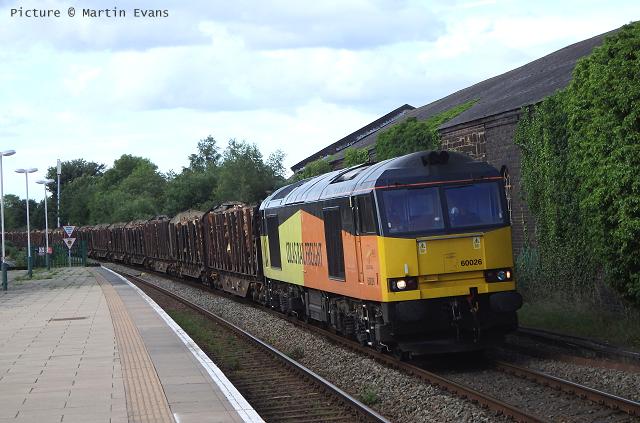
60 026 again, on 22 June at Wrexham General with the loaded train for Chirk (Martin Evans).
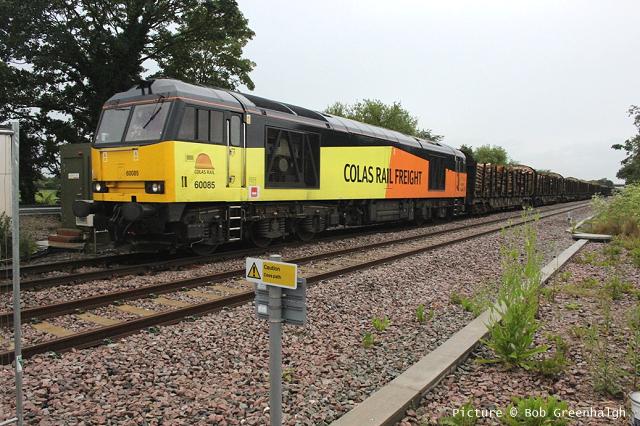
By 28 June 60 026 had been replaced on the log train by fellow Colas loco 60 085, photographed by Bob Greenhalgh at Balderton crossing. The sign says 'Caution: Cess path'. Is it reminding staff there is in fact no safe path alongside the line?
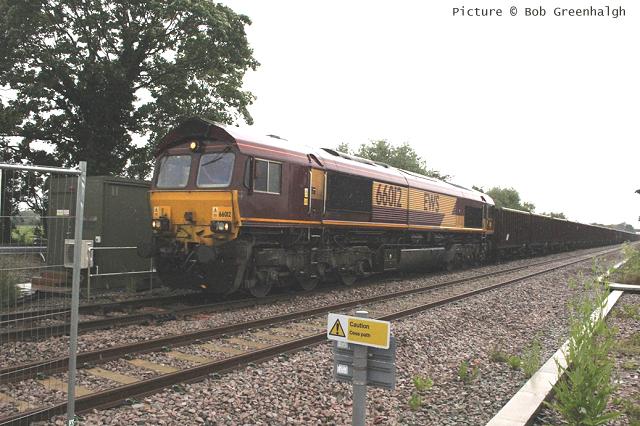
The next day, 29 June, and Bob Greenhalgh braved the rain at Balderton for 66 012 on the coal for Penyffordd, which had left Warrington Arpley sidings three hours late for some reason.
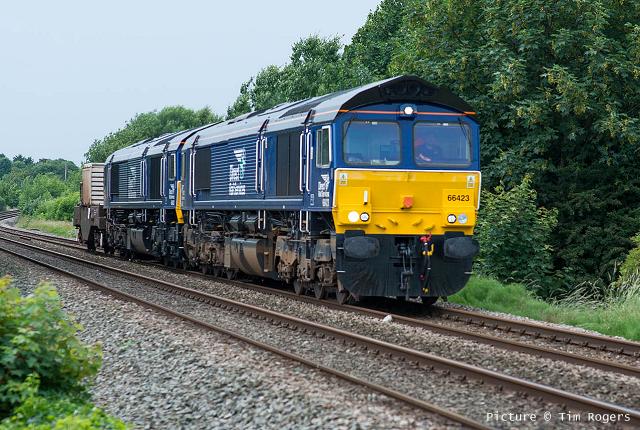
We haven't seen many pictures of the Valle - Crewe flask train recently, but here it is passing Connah's Quay on 1 July with FNA wagon 550060 hauled by 66 423 and 66 432.
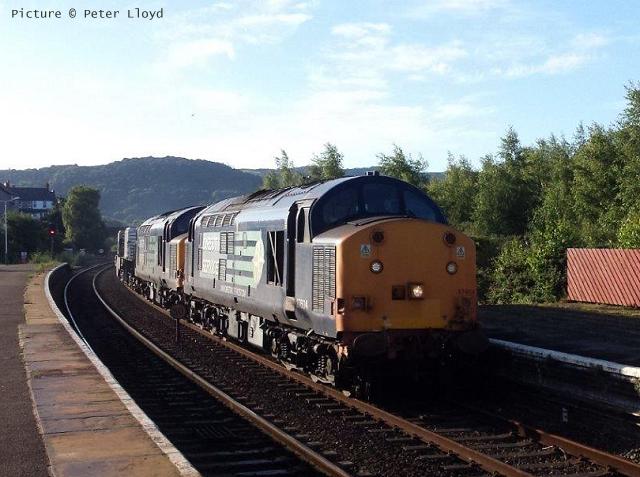
And here it is on 4 July, with 37 604 and 37 607 (Peter Lloyd).
Shotton memories - by Roly High
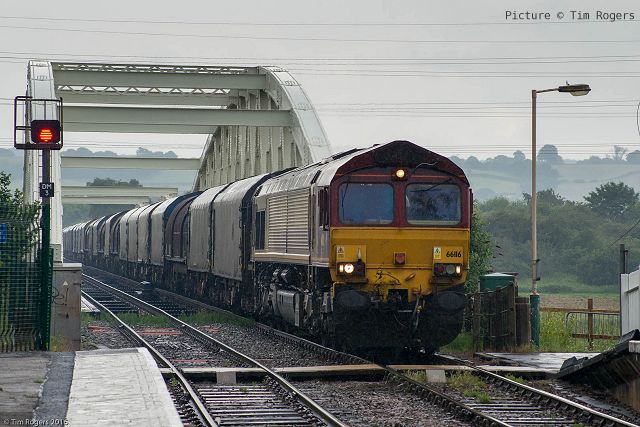
Tim Rogers' picture of 66 116 crossing the Dee with 6M86 10:29 Margam – Dee Marsh - repeated above - brought back memories. How times have changed: this train would, I suppose weigh around 1500 tonnes and is fully air braked. As a young lad living close to that location, I would see numerous coal trains, usually hauled by "Stoke Scots" (4F's) whose loads of coal were needed to turn into coke for the blast furnaces, come to a stand at the other end of the bridge, so the Guard could un-pin the brakes on the loose coupled wagons,which he had pinned down earlier, prior to descending the bank.
Also, on the same subject, these Class 66s and Class 60s now,I would think, take the climb up the bank in their stride. Not so all those years ago,when a train of 'Hy-Bar shochood' wagons, loaded with steel sheet bound for Pressed Steel Fisher at Swindon, which I think is were the Honda factory now is, would keep me awake many a night, by the sound of the ex-GWR pannier tank hauling the train, stalling half way up the bank, and after a couple of attempts to re-start, I would hear its whistle sounding to summon a 'banking' engine from Hawarden Bridge.
Talyllyn 150 Grand Finale
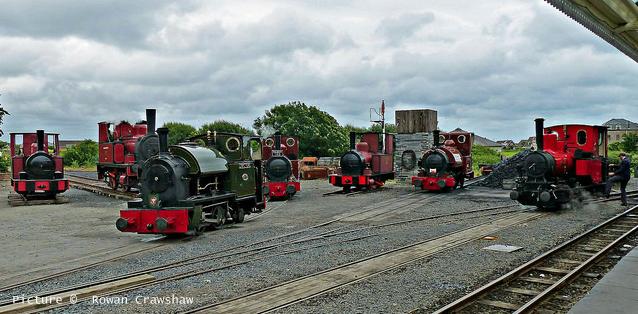
1-3 July saw the Talyllyn Railway stage the last event of the celebrations of the line's unbroken 150 years of service. On display at Tywyn Wharf station (above, picture by Rowan Crawshaw) on 2 July (left to right): Townsend Hook from the Amberley museum, Captain Baxter from the Bluebell Railway, plus resident locos Edward Thomas, Dolgoch, William Finlay, Talyllyn, and Douglas. William Finlay is a recent acquisition for the Narrow Gauge Museum Trust based at Tywyn Wharf station; like Townsend Hook, it was built by Fletcher Jennings & Co. for the Dorking Greystone Lime Co. to the unusual gauge of 3 ft 2½ (or possibly 3 ft 2¼) inches. Captain Baxter is a standard-gauge Fletcher, Jennings loco. Dolgoch and Talyllyn are also products of Fletcher Jennings. That firm, based in Whitehaven, and later known as the Lowca Engineering Co., operated from 1857 to 1912, specialising in small tank engines.
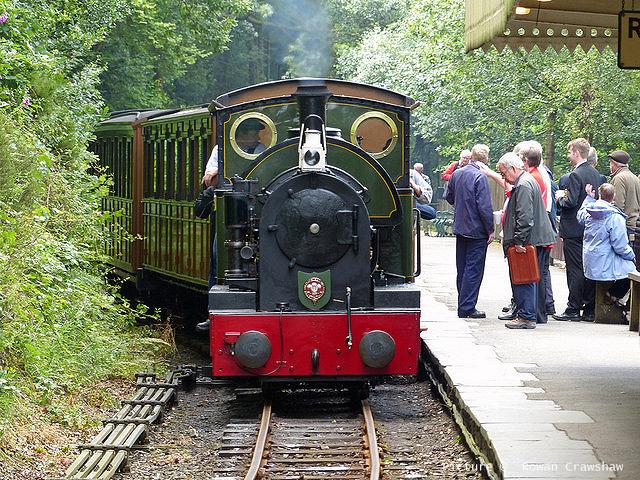
Out on the line, Edward Thomas arrives at Abergynolwyn (Rowan Crawshaw).
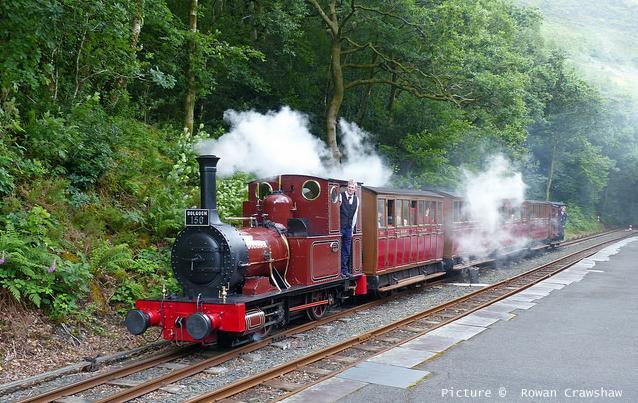
Dolgoch at Abergynolwyn (Rowan Crawshaw).
Douglas and Talyllyn at Nant Gwernol terminus (Rowan Crawshaw).
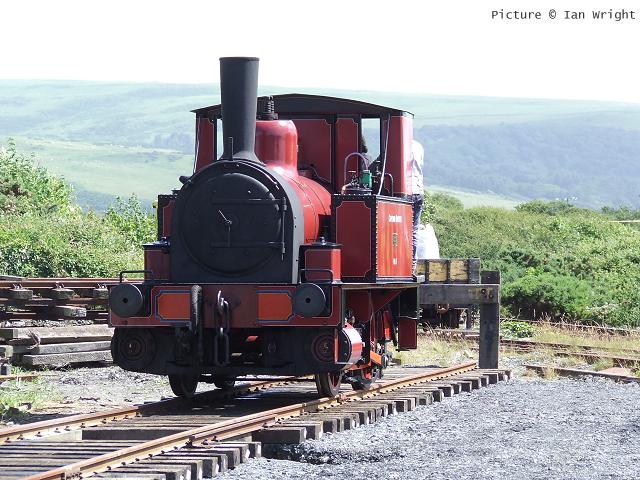
Captain Baxter on his temporary standard-gauge track (Ian Wright).
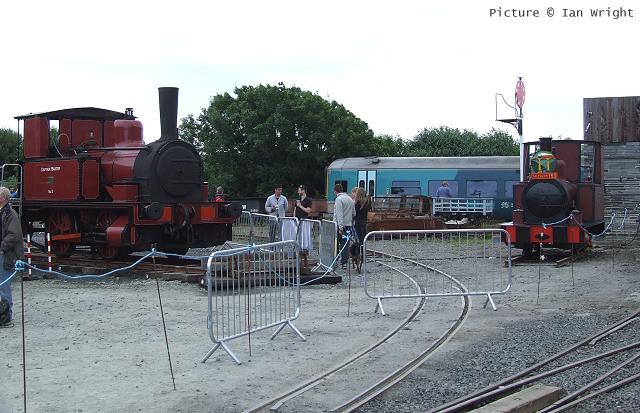
Old meets new(ish) technology at Tywyn Wharf (Ian Wright).
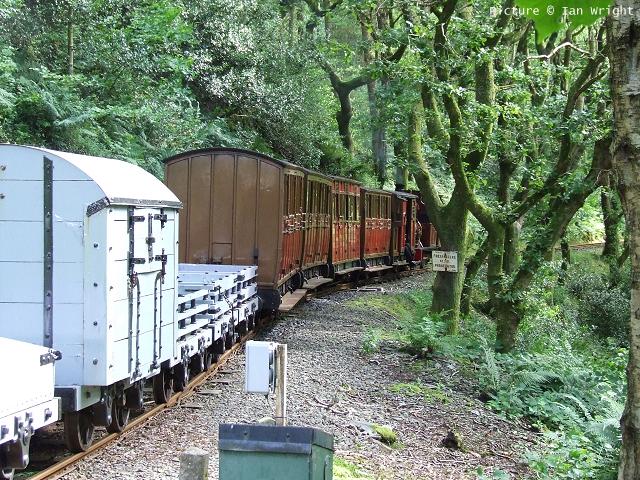
Edward Thomas with Tom Rolt heading for Nant Gwernol with mixed train (Ian Wright).
Passenger views
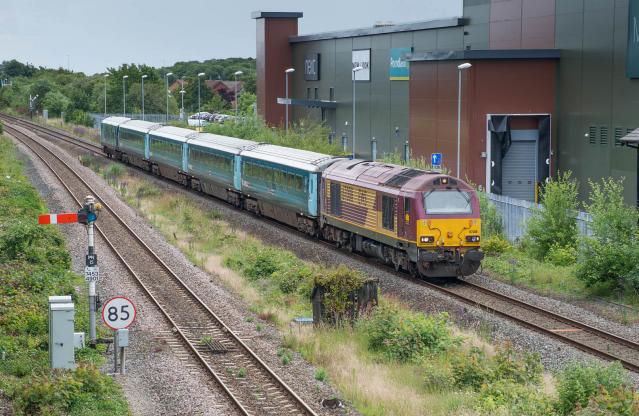
On 1 July, 67 008 was in charge of the 09:50 Manchester - Holyhead 'DfT' traim, see passing the shopping centre at Prestatyn (Tim Rogers). This obvious picture viewpoint for non-car-users seems to under-used, judging by the pictures we receive.
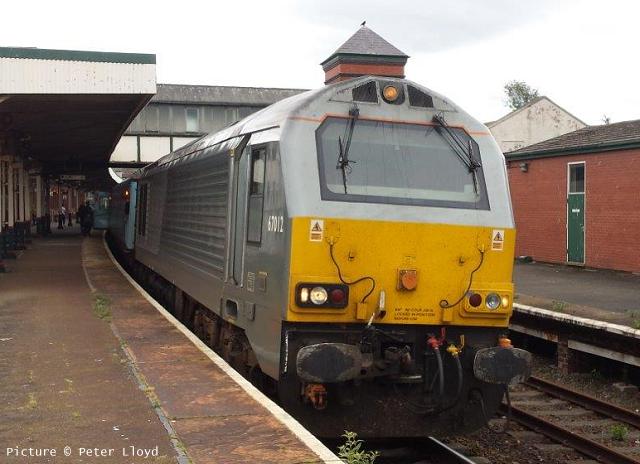
A change of traction and colour: 67 012 calls at Llandudno Junction with the 09:50 Manchester - Llandudno on 4 July. Picture by Peter Lloyd.
On the subject of passenger trains, we have been reminded that in addition to West Coast Railways, Colas and the Rail Operations Group also still use Class 47 locos, although these are not normally seen on passenger trains.
A (wet) narrow-gauge weekend - with Stephen Hughes
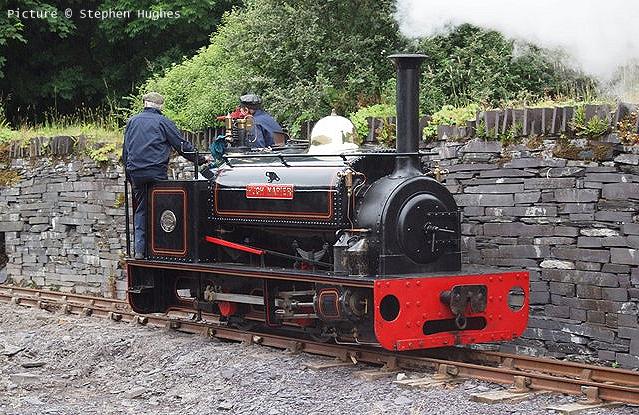
The Penrhyn Quarry railway (PQR) hosted a small gathering in typical Bethesda rain over the weekend of 25/26 June. Visiting locomotives included ex-PQR Hunslet Hugh Napier, (the fifth ex-PQR locomotive to visit the embryonic line) De Winton Chaloner and new-build Ferny Lee.
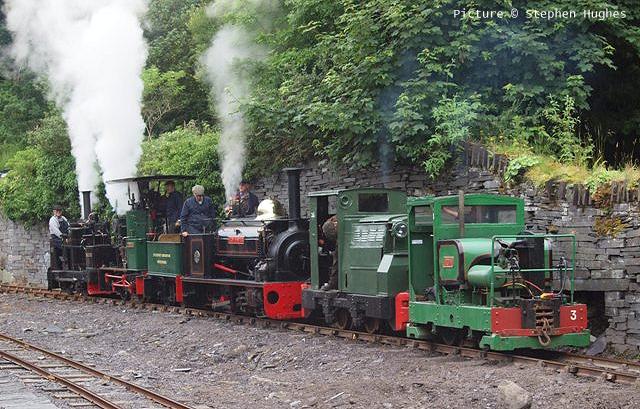
Together with resident Ruston diesel and Simplex Odin, the latter on loan from the Welsh Highland Heritage Railway, the five locos lined up on the recently relaid 'main line'.
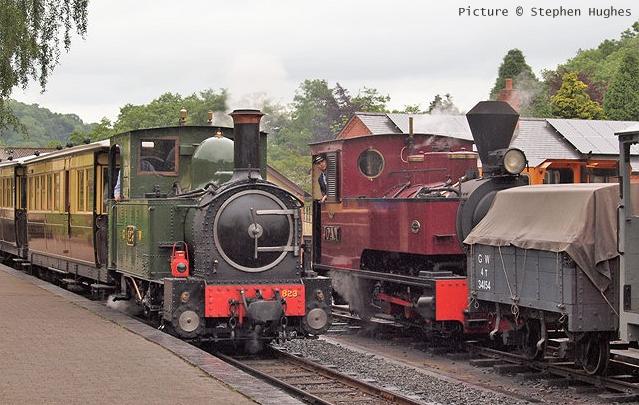
On Sunday I ventured over to the Welshpool and Llanfair Railway, my first visit for some considerable time. The railway was hosting a small 'Country Railway' themed event, with trains hauled by the two original locomotives The Earl and Countess with Joan also in steam hauling a short goods train. The weather was once again unkind and maybe kept the visitor numbers down. I travelled from Llanfair Caereinion to Welshpool and back behind Countess (above) and sampled a piece of 'drama' at Castle Caereinion on the outward journey.
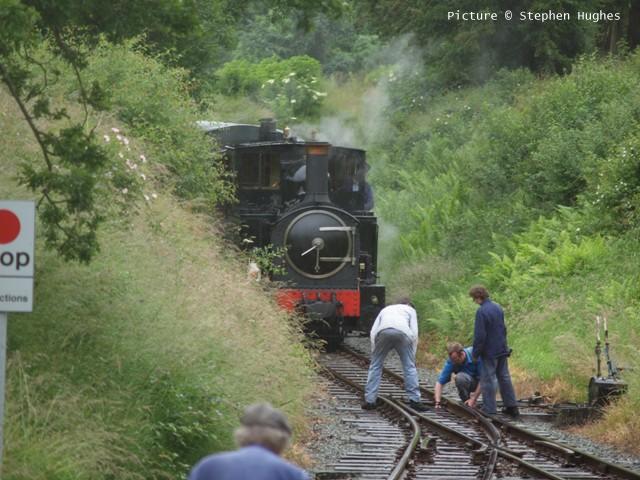
Apparently, the lights on the recently installed road crossing just to the west of the station had malfunctioned, and as they controlled the points for the loop 'Countess' and her train entered the station on the wrong road and locked the points at the eastern end, which meant that 'The Earl' could not enter the station at all.
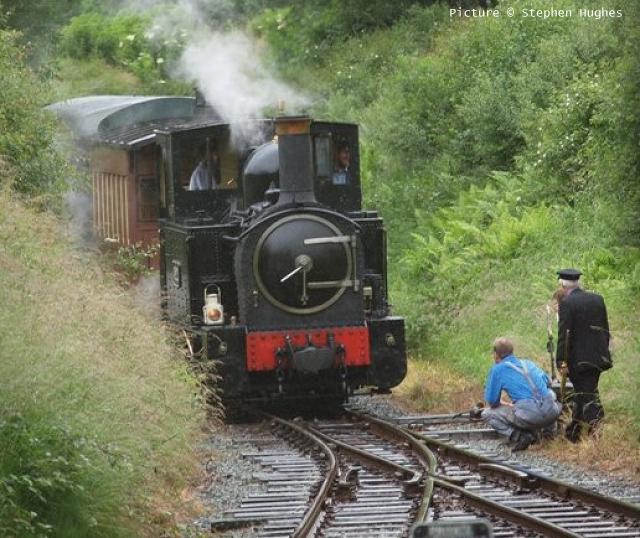
Help was summoned from Llanfair Caereinion in the form of a G-clamp and thus the points were secured to allow The Earl to continue. Although there had been an contributory error on the part of the Signalman, the situation was resolved as quickly as possible and passengers were kept informed by the friendly Guard. Countess resumed the journey after a delay of about 40 minutes.
The photographs show staff clamping the points and The Earl moving gingerly across them to reach the station.
Moving a mountain, or, Peak to Peak - Pictures by Phil Clarke
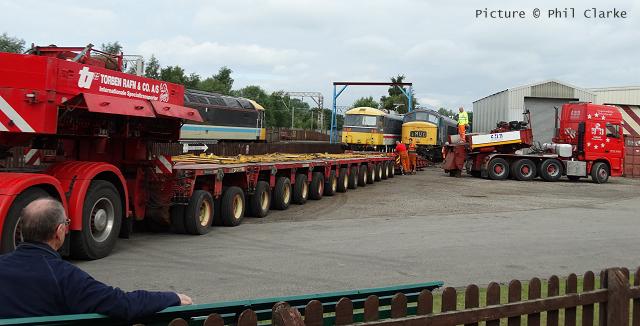
A sequence of pictures taken at Crewe Heritage Centre on 22 June, of class 46 'Peak' 46 035 Ixion, being loaded onto a low loader for movement to Peak Rail in Derbyshire. On the left of the picture is 47 712, which was repainted in Scotrail colours in Summer 2015.
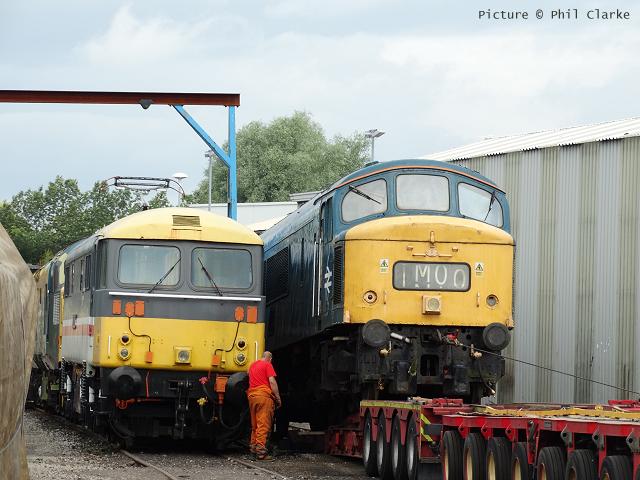
On the left, another 035: resident loco 87 035 Robert Burns; one of three of the 36 Class 87s built in 1973-4 that survive in the UK, the remainder having been scrapped or exported to Bulgaria.
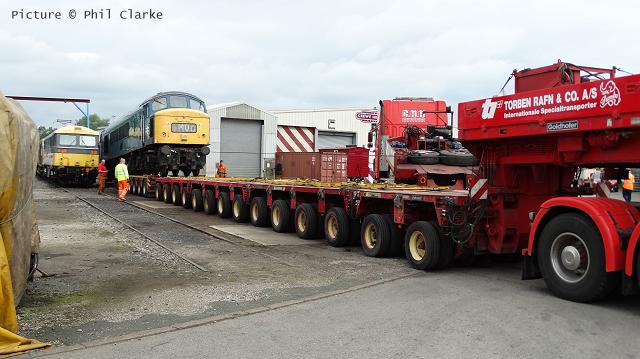
The 46 is the last of Pete Waterman's locos to leave to their new home at Peak Rail. Note the cable from the winch to haul the loco on to the trailer. These locos of classes 44, 45 and 46 have always been known generally as 'Peaks' because the first ten built, later Class 44, were named after mountains.
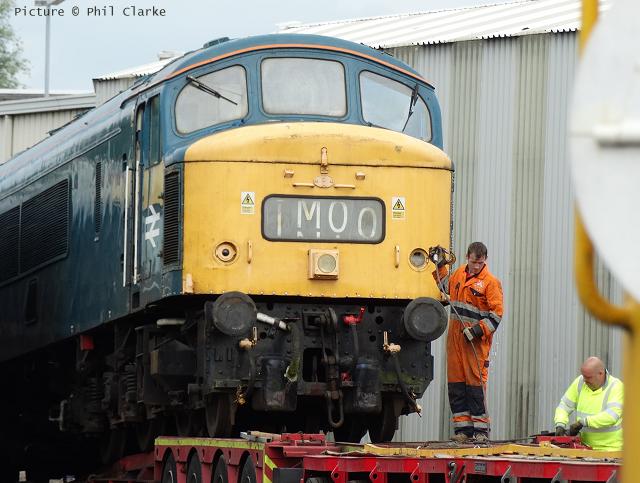
To load the loco on to a 14 axle, 112 wheel, trailer required two tractor units to be sent, along with a second trailer which contained the ramp. In this view the operatives have disconnected the cable, presumably for some adjustment.
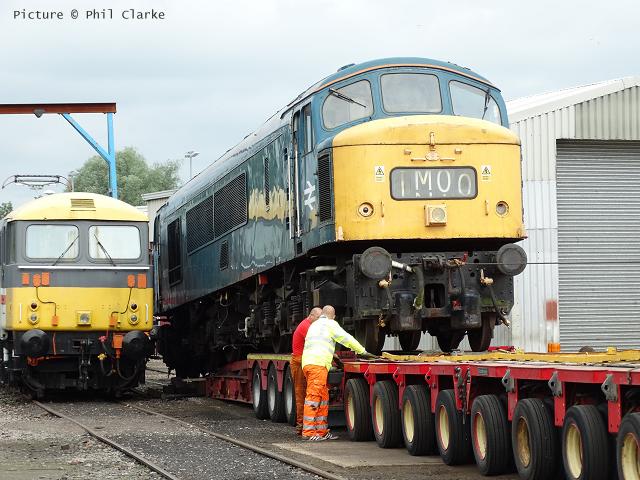
Moving again ...
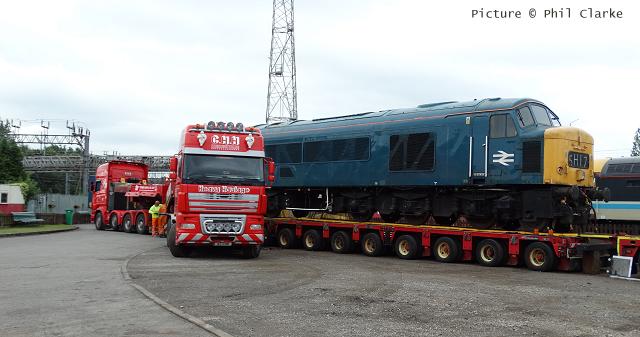
... in position ...
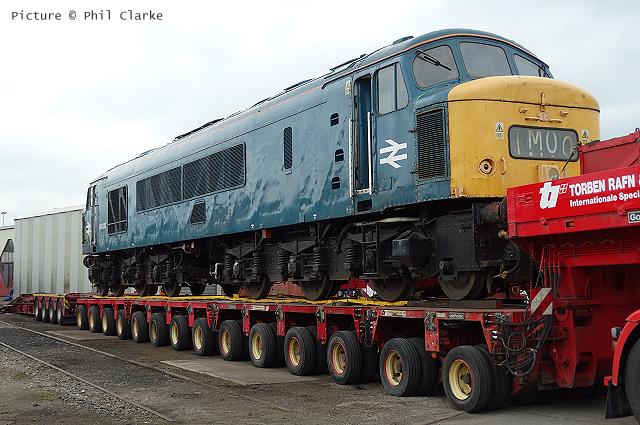
... and ready to roll. The great length of this type loco was governed by the requirement to add 'carrying wheels' each end to reduce the weight carries by each axle to a level acceptable to the railway's civil engineer. Later, an improved, lighter, version was developed, which did not need the extra wheels - the familiar Class 47.
46 035, originally numbered D172 when it entered service in 1962, was one of a group of locos allocated to Gateshead depot, principally for use on the North East - South West and Trans-Pennine routes, although it reached many other routes in its career. Most of the class were withdrawn in the 1980s; this one was taken out of traffic in 1984. Its current livery more or less represents its condition at that time, except that the preservationists have re-instated its four-digit headcode display. However, it survived, claimed by the BR Research Centre at Derby, and renumbered 97 403 in the 'Departmental' series. In 1985 it received equipment for adhesion testing, and was repainted in a red and grey livery with the name Ixion, from Greek Mythology. It last operated some time around 1990, and in 1993 it was sold to Pete Waterman and passed into preservation. In October 1994 it made history by being the first preserved diesel to operate a passenger train on British Rail lines, with a run from Derby to St Pancras.
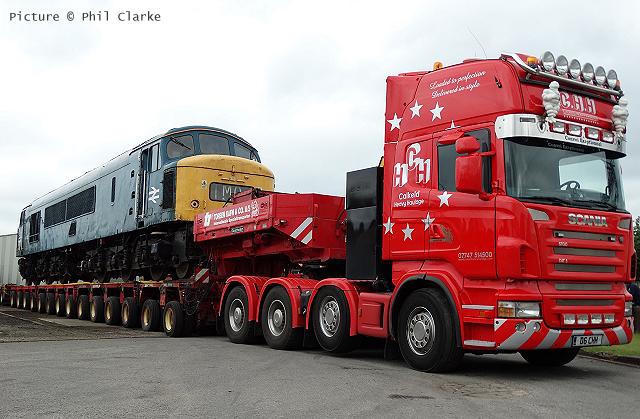
At around 138 tons, These locos are among the heaviest single items of rolling stock ever to run on British rails, a special challenge for the people at Calkeld Heavy Haulage, who have posted severe pictures of the journey on their Facebook page. The trailer is apparently on hire from Danish firm Torben Rafn.
Halton Curve thoughts - by Chris Poole
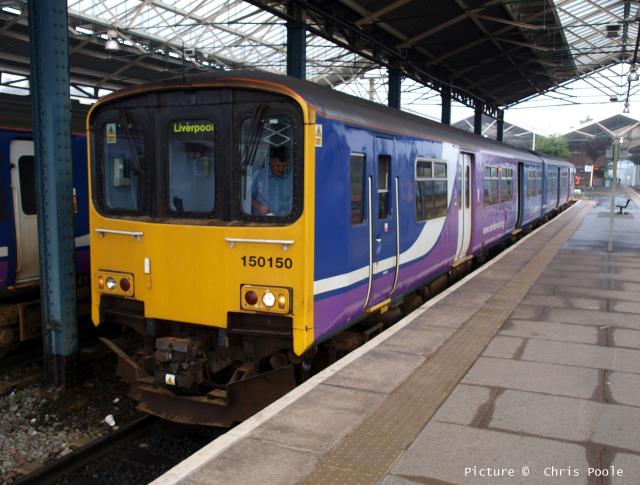
I note the recent reference to a ticket that can be used to make a journey on the Halton Curve. I live in Hartford, almost equidistant from Hartford station (West Coast Main Line, served by Liverpool - Crewe - Birmingham services) and Greenbank (on the Mid Cheshire Line). Although the two stations are about a mile apart (on foot) the journey, from one to the other, by rail involves three trains.
Most of the time the route is Greenbank - Chester - Crewe - Hartford, but a couple of years ago I used the Halton Curve instead. Tickets are flagged "via Chester", but Greenbank - Chester-Runcorn - Hartford is a perfectly valid route on a summer Saturday morning. The shot of 150 150 at Chester is interesting because the train carried Liverpool as its destination; at that time it ran empty from Runcorn to Liverpool South Parkway.
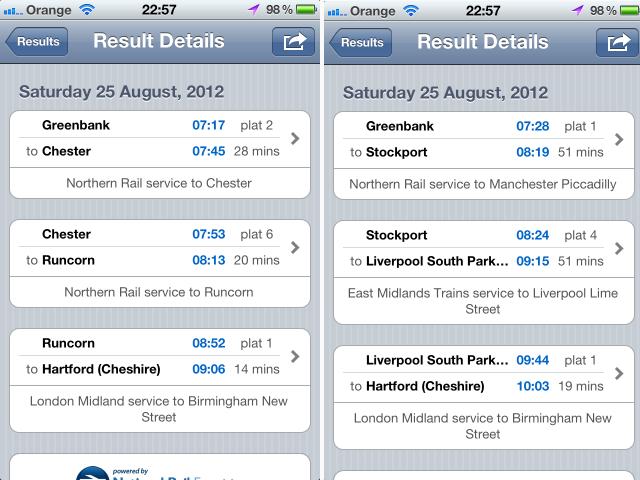
Above are screen-shots of the National Rail app's suggestions for my Saturday journey. Only a journey via Crewe came up when I submitted the same inquiry on Tuesday 28 June.
Editor's note: The train from Chester is currently timetabled to continue empty to Liverpool Lime Street, but what happens to the unit? Real Time Trains shows it running as empty stock train 5F26, arriving at Platform 3 at Lime Street, to form 2F26 09:47 to Warrington Bank Quay. It is unlikely that Runcorn appears on Northern's train destination blinds, as no other Northern trains use that station.
Manx Journey - with Alan Crawshaw
We recently travelled to the Isle of Man for a short break. With a Railcard, the fare is a very reasonable £56 return from Bangor, covering the train to Liverpool and ferry to Douglas. Unlike the SailRail to Dublin, the booking office clerk has to phone through the names of all passengers and railcard serial numbers to the Isle of Man Steam Packet Company who issue a booking reference which the clerk writes on the back of your tickets, so it's advisable to visit at a quiet time, such as just after a train departure. You can also book online but we needed bike reservations also.
After a sunny Thursday ride, Friday was our day for the tracks. I'd worked that it was possible to cover the entire system with a £16 'Go Explore' ticket but it had to be Friday since the last tram was earlier on the other days we were there. Our timetable was:
| Steam Douglas dep 09:50 Port Erin arr 10:50 Port Erin dep12:00 Douglas arr 13:05 Horse Sea terminal dep 14:00 Douglas (Derby castle) arr 14:15 Manx Electric Railway Douglas (Derby castle) dep14:40 Laxey arr 15:10 |
Snaefell Mountain Railway Laxey dep 15:15 Snaefell arr 15:45 Snaefell dep 16:10 Laxey arr 16:40 Manx Electric Railway Laxey dep 16:40 Ramsey arr 17:25 Ramsey dep 17:40 Douglas (Derby castle) arr 18:55 |
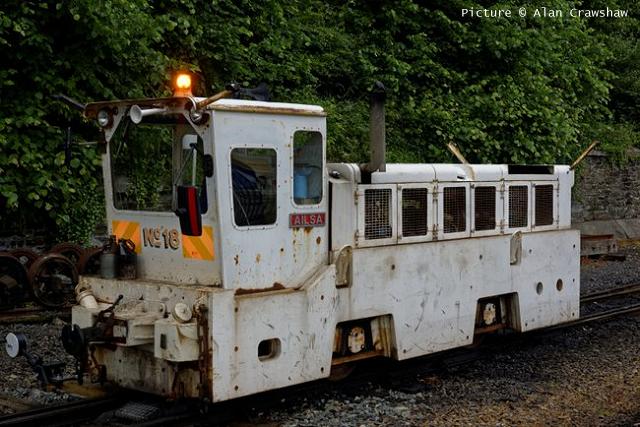
At the Douglas terminus No. 18 was pottering about. It was built in 1994 by Hunslet and sold on by the contractors after its work on the Jubilee Line Extension was complete. It was named Ailsa in honour of Angus Kennedy, Marquess of Ailsa who had kept the railway going in the late 1960s before relinquishing it in the face of mounting financial losses. Two of the three steam lines were closed, leaving only the one to Port Erin.
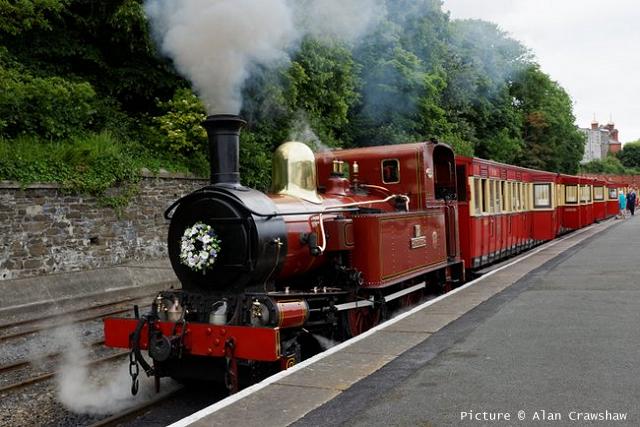
We boarded the 09:50, well filled and hauled by 12 Hutchinson, built in 1908 by Beyer Peacock and named after a company director. We were late into Castetown which kept the 10:00 from Port Erin waiting, on arrival at the southern terminus we looked round the small railway museum at the end of the platform before a pint of the excellent Okells bitter and a return on the next departure, the 12:00.
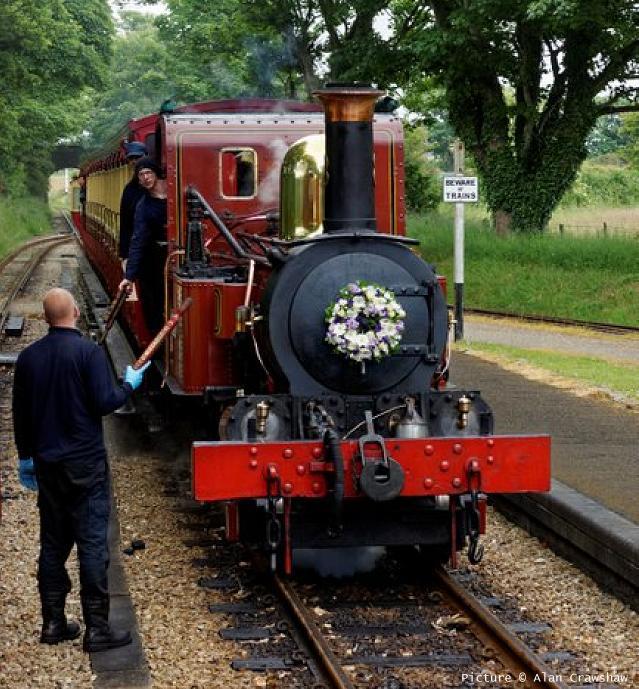
Again the southbound service was late into Castletown so we had a long wait here, the crew exchanging tokens with No 8 Fenella, also a product of Beyer Peacock but from the Victorian era at 14 years senior to Hutchinson. There were few passengers on our train but number 8's was busy. The stock is well maintained and very comfortable, a very pleasant ride.
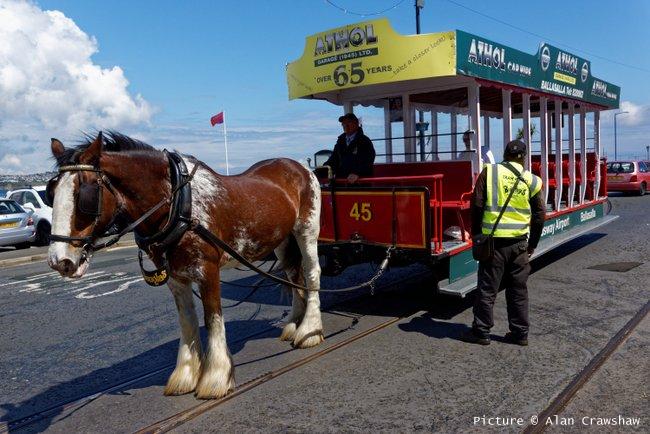
We walked the short distance to the sea terminal for our horse drawn tram along the promenade to the Manx Electric Railway (MER) terminus at Derby Castle. At the beginning of the year, Douglas Borough Council announced that the tramway had run for the last time the previous September and that they had closed it as it was not financially viable, having made a loss of £263,000 in 2015. Luckily for us, they rescinded this decision for the 2016 season but the tramway's longer term future is still precarious. Our horse was changed over at the stables just before the terminus, where the lady from the booking office came out to give it a treat of a carrot.
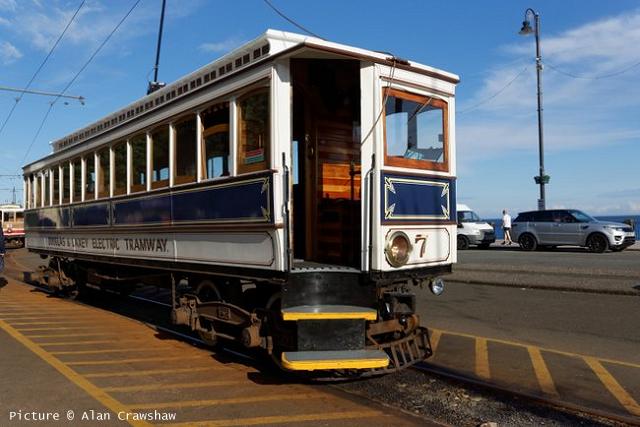
Soon we were riding steep up on the 14:40 MER tram to Laxey to connect with the Snaefell Mountain Railway tram to the top of the island's highest point at 2034 ft.
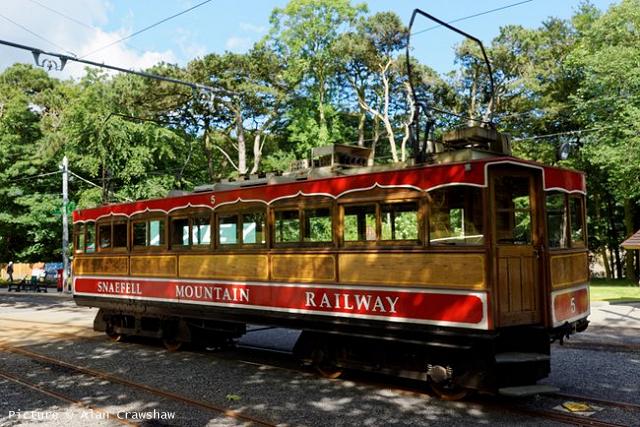
There's a pre-recorded commentary on the way up, pointing out sites of interest.
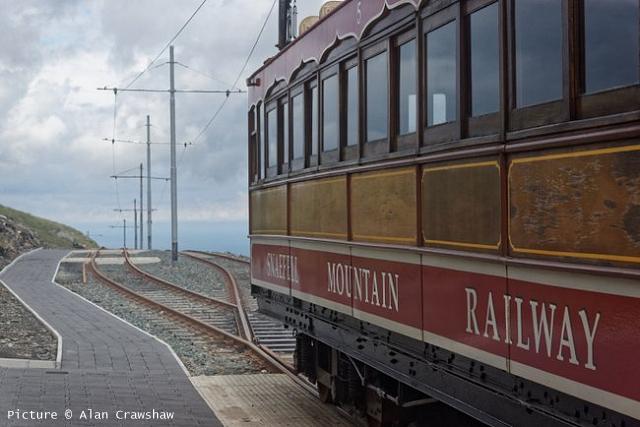
There are spectacular views on this and on the MER.
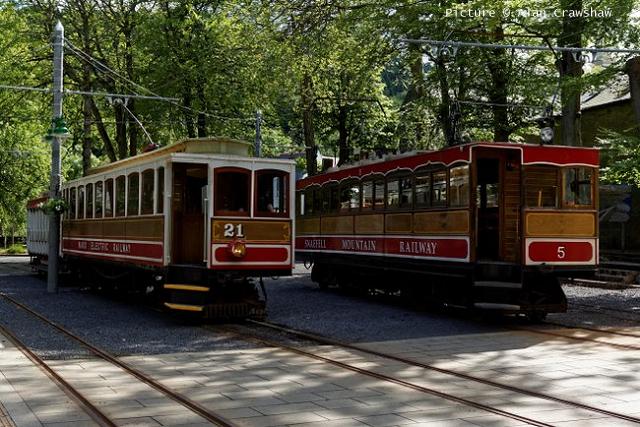
We visited the café and returned to Laxey (above) to continue on to Ramsey.
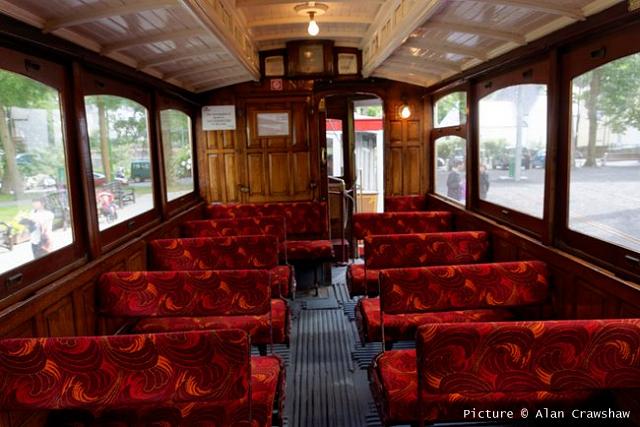
With only a fifteen minute turn-round we had no time to look at the town, we stretched our legs and then enjoyed the uninterrupted run back to Douglas. The interiors of these winter saloons, dating from 1899, are very well appointed.
We returned home on Monday with a remarkably quick journey from Douglas. The Manannan ferry left at 07:30 and arrived a little earlier than its scheduled arrival time of 10:15 enabling us to catch the 10:17 from James Street. The Manchester to Holyhead loco-hauled with 67 008 at the front was in platform 3 as we arrived at Chester, I didn't think we had a chance of making it but I took my bike over via the steps, the train manager opened the Driving Van Trailer door for me and the others arrived from the lift just in time so we were back in Bangor at 12:02.
Were you there to see 4472?
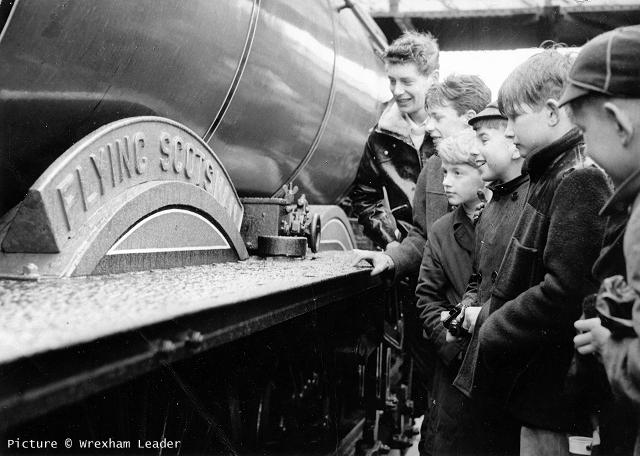
Inspired by our recent pictures of Flying Scotsman's 1963 visit to Ruabon, Robert Meredith shares with us this newspaper photographer's posed picture of the event. The bloke second from right is perhaps a fan of the GWR 'Kings'. Does any reader remember the day he was photographed at Ruabon?
North Wales Coast home page | Archive | Previous Notice Board